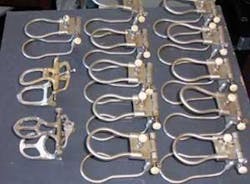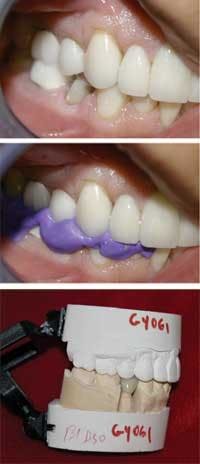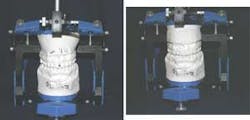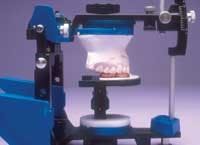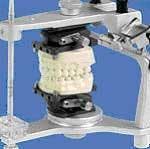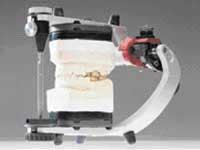Equipment and materials for occlusion-oriented dentists
In the September/October edition of Dental Equipment & Materials (see “The debate over occlusion”), we considered that the teeth and jaw joints are not immune to the same laws of physics that govern everything else in nature. For this second article, we will look at some of the dental instrumentation we can use to examine the biomechanical system outside the oral cavity and fabricate biomechanically correct treatment.
Nature does not always form the physical universe in a way that best suits the needs of mankind. Rivers do not always flow in the right direction to bring water for irrigation. The oil and natural gas reserves are often buried in inconvenient locations. Shelters often have to be constructed in ways to counter nature’s forces, such as earthquakes or hurricanes. Likewise in the natural dentition, there are often conflicts between the teeth and jaw joints. In order to enhance quality of life, human beings have always sought to improve upon what nature provides in an appropriate manner. As this relates to occlusion, the teeth and jaws must be in harmony to minimize the transmission of destructive forces, ensure proper function, and avoid system failure. This concept of balance and harmony is fundamental to any natural system.
As long as teeth have suffered the ravages of diet and biomechanical overload, there has been science to provide treatment. Earliest repairs were performed directly on the teeth by attempting to wedge or wire repairs directly to them. Evidence of these early dental efforts - both reparative and “cosmetic” - have been found in the tombs of ancient Egypt. The next major evolution came when direct materials such as cements were developed to fill the holes in teeth. Decades later, dental amalgam - although always a controversial material - was developed and had the advantage that it could be mixed outside the mouth, placed directly into a cavity, and shaped as it was setting, much like contemporary composite dental resins. In the case of very large cavities or the replacement of missing teeth, it is often necessary to fabricate restorations outside the mouth, then transport them inside the oral cavity for final placement.
When fabricating indirect restorations, the more knowledge the dentist has of how the teeth and jaws work in harmony and the implications of the new restorations, the more accurate the repairs will be and the longer they will last. This is not unlike building a house where an engineer is called upon to specify the types of materials and support system to maximize strength and durability. Models are often created both in form and on computer for careful examination and analysis of loads and weight distribution. In dentistry, we have the similar requirements and also require specific instrumentation for analysis and indirect fabrication prior to placement.
Early dentists recognized that it was not easy to understand or evaluate the intraoral forces in the oral cavity itself. They realized that it would be necessary to construct “models” or “simulations” of the teeth and jaw joints so that the relationships could be studied outside the mouth and then lessons learned could be applied. The early dental engineers (probably best represented by the forefathers of the gnathologists) took a mechanistic viewpoint and used their talents to create instruments that would simulate the natural movements of the jaws as they understood them. It is storied that the first articulator was created more than a century ago when a dentist mounted a case to a slightly modified barn door hinge. These articulators could have been produced as early as 1910 (see photo below).
The dental articulator is utilized to provide a simulation of the position and movements of the teeth relative to the jaw joints outside the oral cavity for the unobstructed study of natural tooth and jaw movements. This information is used to fabricate restorations that will be in harmony with the biomechanical system. The more information that the dentist and technician have about the teeth and the jaw joints, the more accurately they can fabricate the restoration. A more accurate fabrication has the advantage of requiring less alteration in the oral cavity. The alteration of which most dentists and patients are aware is when the restoration is in interference with the natural bite of the patient and must be “ground-in.” Sometimes this grinding can result in loss of proper contour and esthetics. In addition, removal of too much material can result in the exposure or perforation of the substructure. This can result in a cosmetic or even structural failure that necessitates the refabrication of the restoration at no small expense to the dentist and patient. A more insidious problem is if the restoration does not meet the opposing teeth properly. It may not “feel bad” to the patient, but the failure of the restored tooth to carry its fair share of the occlusal load will create the unintended consequence of overloading the other teeth, which may result in premature damage and/or future tooth loss.
Before we start to consider the specific type and features of an articulator, a dentist might consider it is important to realize that articulators are a lot like computers - GI/GO, garbage in = garbage out. Articulators are not magic. They simply take what we give them, then they show it back to us. For that reason, it is imperative that the practitioner is able to relax the jaw muscles, center the jaw joints, and capture an accurate bite record for case mounting.
A popular technique is the Best-Bite Discluder, which is customized by lining it with bite registration material and setting it on the patient’s upper central incisors. It is completely flat from side to side and front to back, allowing unrestricted and smooth movement for the lower incisors. The 8 degree incline of the occluding side encourages the lower incisors to gently track back and up so as to guide the condyles into a centered position and to simultaneously help relax the muscles. The bite record for case mounting is captured by injecting bite registration material between the posterior teeth at the comfortable position established by Best-Bite. The case is then mounted on the articulator using Best-Bite and the posterior bite records. After mounting the case, be sure to confirm first contacts and working and balancing interferences in the mouth and on the mounted models with a marking ribbon to ensure accuracy in the bite recording and laboratory mounting procedures. Another suggestion to ensure accuracy of the mounting is to be sure that wear facets on the models can contact when the articulator is moved laterally or protrusively.
Over the years, there have been many different types of articulation systems. The decision as to what type or concept of articulator the dentist needs depends on the case being considered and the outcome desired.
When selecting an articulator, the primary questions are:
- Will the dentist accept the current relationship of the teeth and the jaw joints or will changes be made?
- What is the number and location of the teeth being repaired and/or replaced?
Sample case 1
The dentist is restoring just one or two posterior teeth (in this example, one) and the bite is considered to be stable and functional and will not be altered. The plan is to simply restore the functionality of the damaged tooth into harmony with the rest of the dentition.
The requirements for this case are:
- An articulator that will allow for a removable die for wax-up and casting.
- Reasonable stability to accept and maintain the position of maximum intercuspation.
- Examination to ensure simultaneous tooth contact with the other teeth in the position of maximum intercuspation and does not interfere with the excursive movements of the remaining teeth.
If the procedures are performed precisely, the required contacts should be present and, at most, there should only be slight excursive modifications required on the final restoration in the mouth. Here is an example of a simple articulator for this purpose. Figures 1-3 show single posterior preparation maintaining occlusion requires simple articulation.
Sample case 2
The dentist is treating a case where there is significant damage to the dentition and the fundamental bite needs to be modified and restored. In a case such as this, there are many factors that should be considered and, as a result, a more flexible instrument is required for optimal results. Some of the major factors include:
- The ability to alter the vertical dimension on the same arc of closure.
- The ability to evaluate and verify the position of the condyles in the fossa.
- The ability to accept check bite protrusive registrations to replicate or simulate the angle of the eminence as it affects the travel of the condyles down and forward as the patient opens and protrudes his or her teeth, and the influence it has on the position of the anterior teeth.
- The ability to be able to create a custom incisal guide table to assist in determining lingual contours of the anterior teeth.
- The ability to have multiple sets of models for wax-up, dies, soft-tissue models, etc., that are easily interchangeable.
- The ability for the doctor and technician to be able to easily transfer models back and forth and use their own articulators for multiple cases.
Figures 4 and 5 show complex restoration with changes to occlusion requires more advanced articulation.
Selecting an articulator
This article is primarily directed toward general dentists who have not recently upgraded their occlusal instrumentation - perhaps since dental school - and want to get up to speed with the new techniques and equipment in treating bite problems. Each manufacturer of dental articulators has many different models to choose from and they all have varying degrees of adjustments. It is beyond the scope of this article to detail all of the features of each model. For more specific information, please contact the vendor directly. It is also beyond the scope of this article to mention every manufacturer of articulators, so the list is limited to the major manufacturers that the author has utilized in his own practice.
The general features that are important in any articulating system are:
- The quality of materials and ability of the instrument to retain settings introduced into the instrument.
- Ease-of-use features such as magnetic mounting plates, built-in mounting stands, simplified face bow, and easy and reliable centric locking mechanism
- Ability to accept average condylar positions from facebow
- Ability to accept hinge axis face bow records
- Ability to upgrade into additional complexity levels without having to completely replace the articulator
- Specific ranges of features and adjustments that meet your requirements
- Ability to work with advanced computerized instrumentation (i.e., mandibular tracking)
Panadent
Shown at right, Panadent 1701 Articulator with Mounting Stand
Panadent was founded by Dr. Robert Lee, who was a restorative dentist as well as an engineer as shown by his articulator design. The Panadent system has a full range of functionality in its line of three articulators (1701, 1801, 1901) that range from $635 to $985 retail. Some of the key features include:
- Reproduction of all major mandibular movements with three-dimensional curved condylar path analogs of motion that include curved path Bennett, lateral border, and protrusive pathways
- A check-bite method for selecting and adjusting preformed condylar motion analogs
- A unique Dyna-Link system for keeping upper and lower articulator frames joined together during eccentric movements
- Arcon-type articulators that open 180 degrees for laboratory waxing and restoration fabrication
- Interchangeability of mounted casts from one Panadent “P” series articulator to any other Panadent “P” series articulator
- Scientifically determined fixed condylar axis elements rather than adjustable “inter-condylar” distance
- Articulators that can be adjusted using the Panadent Axi-Path recorder or interocclusal “check-bite” records
- Articulators designed for use with both true hinge axis and arbitrary axis face-bows
- A fixture which allows cast mounting on the articulator without attaching the face-bow to the articulator
Whip Mix
Shown at right, Whip Mix Articulator with InstaMount
Whip Mix is one of the finest dental companies with an excellent range of clinical products and laboratory supplies. Whip Mix features a line of six different models - the 100, 1000, 2000, 3000, 4000, and 8500 series - based on research from the renowned gnathologist Dr. Charles Stuart. Each model has several variations and range in retail price of $116-$518.
Some of the key articulators and features of the Whip Mix line include:
- InstaMount Mechanical Mounting System, designed for mounting upper and lower models on Whip Mix articulators quickly, neatly, and precisely without plaster
- Adjustable condylar inclination with curved eminentia and immediate side shift
- Fixed inter-condylar distance of 110 mm
- A posterior stop which allows the user to remove the incisal guide pin
- A retractable anterior leg for optimum tabletop viewing
- Upper frame which can easily be set at an open position for convenience during laboratory procedures
- Bilateral elastics provide optimum feel during excursive movements and can be easily detached to remove the upper frame
- Tracking fossa which allow upper and lower frames to remain together during excursive movements
- “Accumount” Mounting System makes it possible to exchange mounted casts between Whip Mix articulators without loss of accuracy
KaVo
Shown at right, KaVo Protar Evo 7 Articulator
KaVo is one of the leaders in providing equipment for the dental operatory. The Protar Evo line of articulators represents the finest level of German precision and craftsmanship. The line of three instruments offers a variety of features and ranges from the Protar Evo 3 to the Protar Evo 7 with retail prices from $1,069-$2,086.
The KaVo Protar system of articulators is designed to cover a full range of complexity and utility from the relatively simple Protar 2 to the electronic measuring system KaVo ARCUSdigma. The KaVo articulator PROTAR Evo offers unbeatable efficiency and precision.
- The elegant design of the KaVo PROTAR Evo presents the finished prosthesis at the highest level
- Optimum setting of the patient’s data by use of the large dimension adjustment scale
- Smooth surfaces with distinctly less edges and corners enable first-class removal of such materials as plaster, and greatly reduces the problems of maintenance
- Advanced materials offer super light weight
- The secure fixing of the articulator upper section also prevents an unintentional separation of the articulator even if the centric locks are open
- The movements of the articulator are exactly guided by spring elements
- Adjustable saggital condylar path from -10 to 90 degrees
- Adjustable horizontal condylar path from 0 to 30 degrees
- Adjustable protrusion, retrusion, and distraction of up to 1.5mm
WaterPik
For several decades, WaterPik has carried on the tradition of quality and precision of the Denar and Hanau lines of articulation systems. Systems range from the simple Combi to the fully adjustable D5A system. Suggested retail pricing begins at $695.
- Semi-adjustable, Arcon-type modular articulator and fully adjustable articulators
- Complex computer-machined, Radial Shift curvatures are already carved into the fossa
- The Modular Articulator permits you to select guidances that will help you achieve optimum cusp/fossa harmony
- The feature of the curved 19 mm (3/4-inch) radius simulates average anatomical movements
- Two different types of incisal guides are available - one for use with fast-setting acrylic while the other guide is adjustable anteriorly/posteriorly and laterally
- Precision machining allows transfer of casts from one Modular Articulator to another
- Adjustments: protrusive angle 0-60 degrees; immediate side shift 0-4 mm; progressive side shift 0-30 degrees; rear wall 30 degrees backward; top wall 30 degrees up, 30 degrees down; inter-condylar distance 90-150 mm
- Medial and Superior wall inserts - removable for custom grinding, choice of curvatures
- Adjustable incisal table (T3), custom step incisal table (T2), and long centric incisal pin (P2) are standard
- Lingual visibility allows for easy viewing and access to models from the rear of the instrument
Summary
Using an articulator allows the dentist to accomplish many very important things. First, it allows dentists to do the same type of simulation and analysis that is fundamental to all other areas of modern science. The way we simulate the patient’s jaw movements and see how they affect the teeth and joints is conceptually similar to how meteorologists create simulations to anticipate hurricanes for forecasting and research and architects design buildings and bridges.
Second, it enables the dentist to focus on patterns of wear and damage that might easily be missed with a routine clinical exam. This is essential because, by enhancing visibility, we also enhance the power of observation and discover things that were always there but escaped notice. In addition, mounted cases are excellent patient education tools. Patients cannot see in their own mouths, but many are interested when we offer them the opportunity to hold an articulator in their hands. They notice how worn edges line up and how teeth have moved and shifted and look “crooked” in ways that were not easily perceivable in the mouth. The more interested and involved patients become, the more ownership they take in their problems and the more interested they become in solving them.
And, most importantly, the articulator allows the dentist and laboratory technician to create a cosmetic and functional restoration that will be in harmony with the patient’s face and jaw joints. The closer we can get in the dental laboratory to the final case, the less work is needed in the patient’s mouth. This saves dental chair time, reduces stress for the dentist and patient, and results in a more professional presentation.
Dr. Jerry Simon has been an active dental practitioner in Stamford, Conn., for more than 30 years with a focus on bite dysfunctions. He is also the author of the book, “Stop Headaches Now: Take the Bite Out of Headaches,” more than 30 articles in dental/medical journals and inventor of the Best-Bite Discluder. He can be reached at [email protected] or by calling (888) 865-7335.

